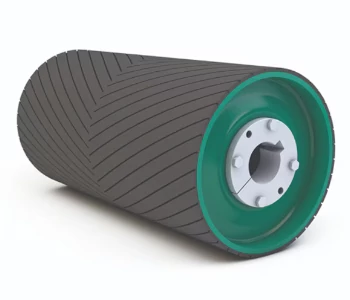-
Call Us +971 67657121
-
Send Message [email protected]
-
Our Location UMM DEARA, AL TAWOON NEW INDUSTRIAL AREA, UMM AL QUIWAN
Pulleys
Pulleys

A conveyor pulley is a crucial mechanical component in belt conveyor systems, serving various functions such as driving, redirecting, and applying tension to the conveyor belt. These pulleys play a vital role in the efficient movement of bulk materials across various industries, including mining, manufacturing, and logistics.
There are different types of conveyor pulleys, including drive pulleys, return pulleys, and bend pulleys, each designed for specific applications within the conveyor system. The proper selection and installation of these pulleys are essential, as they can significantly influence the overall efficiency, reliability, and longevity of the conveyor system. Factors such as material composition, diameter, and load capacity must be carefully considered to ensure optimal performance and minimize maintenance costs over time.
Type of pulleys
Head pulley
The discharge end of a conveyor system, where material is transferred to another conveyor, is known as the head end. The pulley located at this end is referred to as the head pulley. This component plays a crucial role in the overall operation of the conveyor. Typically, the drive mechanism is attached to the head pulley, which necessitates its design to be larger and more robust than other pulleys within the system.
To improve the traction between the conveyor belt and the head pulley, the head pulley is often coated with a layer of rubber known as lagging. This rubber lagging enhances the frictional grip, reducing the likelihood of slippage during operation and ensuring smooth and efficient material transfer. Additionally, a well-designed head pulley helps to maintain the correct alignment of the conveyor belt, thereby extending the lifespan of both the belt and the pulley while minimising maintenance needs.
Tail pulley
The pulley that is located at the end of the conveyor system, known as the tail pulley, plays a critical role in the operation of the conveyor belt. In many cases, this pulley is equipped with a screw take-up mechanism, which allows for adjustments in belt tension. This adjustability is essential for maintaining optimal performance and preventing slippage.
The tail pulley also facilitates the necessary changes in direction for the belt, whether for the take-up arrangement or various drive configurations. Its design ensures stability and support during these directional shifts, helping to maintain the integrity of the conveyor system. This support is crucial for preventing wear and tear on the belt, thereby extending its operational lifespan.
Snub Pulley
Snub pulleys are strategically integrated into the design of conveyor systems to enhance the wrap angle of the conveyor belt around the drive pulley. By maximizing the contact area between the belt and the pulley, a larger wrap angle enables the transfer of greater torque to the belt as it travels around the drive pulley. This increased friction minimizes the likelihood of slippage, ensuring that the belt can effectively transmit power, even under heavy loads or lengthy distances. Consequently, the implementation of snub pulleys can lead to a reduction in the number of drive units required, making them particularly advantageous for extensive conveyor systems or those intended for transporting substantial materials. This efficiency not only optimizes operational performance but also contributes to reduced maintenance costs and improved reliability of the system.

